11 Awesome X-Men Facts We Learned From The X-Men Apocalypse Commentary
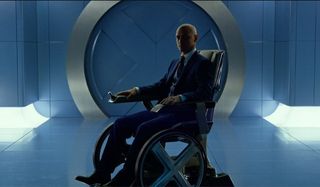
Thanks to a long press tour and many, many interviews with castmembers and filmmakers, the last year has been packed with interesting stories cropping up all over the place about X-Men: Apocalypse. We've been following the development of the movie from its very inception, and as a result have learned many interesting details in the process. Of course, that doesn't mean that we've heard everything about the blockbuster -- as the recently released commentary track for the film proves.
The recent digital release of X-Men: Apocalypse comes packaged with an audio commentary featuring director Bryan Singer and writer/producer Simon Kinberg -- and together they reveal a great number of cool tidbits about the making of the movie and their intentions in specific scenes. All together it's nearly two-and-a-half hours of in-depth comic book movie conversation, but below and on the next few pages we've plucked out some of the best topics of discussion. Read on!

The Full Origins of Apocalypse And Explanations Of His Powers In The X-Men Universe
As it turns out, X-Men: Apocalypse doesn't even really scratch the surface in terms of establishing the history of its titular villain, as Bryan Singer uses the commentary track for the film as an opportunity to trace the character's origins to the dawn of man. The antagonist's original power is his ability to transfer his consciousness from body to body, and he would gain new abilities as he would take over different mutants with different gifts (in the film, as evidenced by the cut that instantly heals, he is taking over a mutant with a healing factor a la Wolverine, Sabretooth or Deadpool). With these abilities, he ruled over civilization -- but whenever a group of rebels would oppose him, he would wipe them all out. This includes the Acadians, the Samarians, and the Babylonians, all leading up to his rule over Egypt. He believed that the Egyptian society was perfect, and with the healing factor he could live forever... but he didn't take into account his Four Horsemen failing him during his transference and leaving him to be buried in a tomb.

The Explanation Behind The Star Trek Episode Playing In Storm's House
In the making of X-Men: Days of Future Past, Star Trek super-fans Bryan Singer and editor/composer John Ottman got permission to feature an episode of the original series in their blockbuster -- and they managed to do the same thing in the making of X-Men: Apocalypse. What you may not recognize, however, is what is special about the particular episode that they selected. As is noted on the commentary, the clip playing on the television in Storm's home is from "Who Mourns for Adonais?" which features the god Apollo, and has a big ending that has the character grow larger than life. This, obviously, was meant to mirror the 2016 feature, which has Oscar Isaac's Apocalypse grow to enormous size while telepathically battling with James McAvoy's Professor X at the end of the movie.
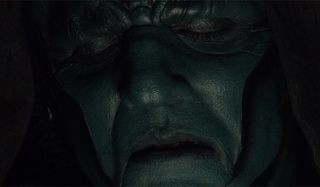
The Very Special Process Used To Create Apocalypse's Voice
Watching Oscar Isaac's performance in X-Men: Apocalypse, you probably noticed that his voice doesn't sound quite human. This is because Bryan Singer and his team used a special technique to try and make the villain sound like a more epic threat. At the end of production, the director brought Isaac in to ADR all of his dialogue, and in addition to using a standard dubbing microphone, he also positioned a bass mic and a drum bass mic on either side of the actor's face. This allowed them to isolate a certain part of his voice pattern that is basically otherwise unnoticeable. When all of the tracks were mixed together, it created the sound of Apocalypse's voice that we hear in the finished cut of the blockbuster.
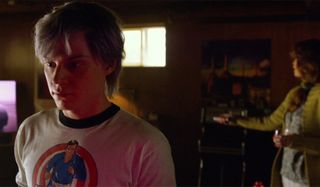
Why X-Men Fans Should Thank Ryan Murphy For Evan Peters' Quicksilver
It's no secret that X-Men: Days of Future Past added Quicksilver to its roster of mutants surprisingly late in the process, but it turns out that Bryan Singer had a very clear vision of how he wanted the character to be portrayed. Specifically, he wanted Evan Peters for the part. Unfortunately for the filmmaker, the young actor was hard at work on the television series American Horror Story, and had a full calendar to compete with. Obviously everything worked out, but as Bryan Singer notes on the X-Men: Apocalypse commentary, fans should all recognize AHS showrunner Ryan Murphy for having a hand in that. He successfully moved the production schedule around to allow Evan Peters to join the X-Men franchise, allowing the young star to create what is universally agreed to be the best sequence in the film.
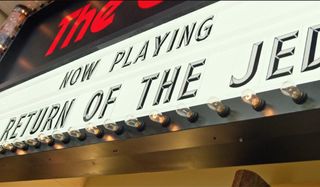
Why Bryan Singer Doesn't See The Return Of Jedi Reference As A Dig At The Last Stand
Bryan Singer famously stepped away from the X-Men franchise after making X2, deciding that he wanted to make Superman Returns instead of what would wind up being X-Men: The Last Stand. Considering that film is widely considered one of the franchises' worst offerings, many have assumed that the X-Men: Apocalypse reference to Return of the Jedi was directly targeted at it (with Sophie Turner's Jean Grey discussing how the third movie in a trilogy is always disappointing). This, however, was now how Singer intended the gag to be taken. Instead, on the commentary he explains that it was more a reference to just how hard it is to make the third movie in a trilogy -- acknowledging that X-Men: Apocalypse sits in this position after X-Men: First Class and X-Men: Days of Future Past. It's worth mentioning that Simon Kinberg -- who wrote X-Men: The Last Stand - was sitting right next to him at the time of the comment, but we're willing to take his word in this matter.
CINEMABLEND NEWSLETTER
Your Daily Blend of Entertainment News
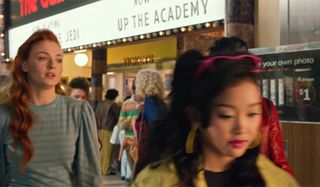
Why The Film Playing With Return Of The Jedi Is Also An Easter Egg
As we will discuss more in a bit, the Star Wars: Return of the Jedi reference gets a lot of attention from fans for its presence in what remains of X-Men: Apocalypse's deleted mall sequence -- but what you probably don't know is that the film that is playing in the same theaters is its own special Easter egg. Back in 1980, director Robert Downey Sr. made a Mad Magazine movie called Up The Academy starring a young actor credited as J. Hutchison -- and that young many grew up to be Hutch Parker, a producer on the X-Men franchise since 2013. Bryan Singer and Simon Kinberg felt that the 1980s setting of the blockbuster was a perfect opportunity to reference Parker's acting past, so they put the name of his only acting credit up on the marquee.
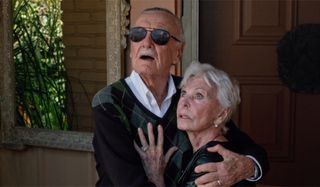
Why Stan Lee's Cameo Is Particularly Special
Since 2002's Spider-Man, Stan Lee has maintained a tradition of cameoing in just about every film based on a Marvel Comic. X-Men: Apocalypse is no different, with the legendary writer appearing on screen as the titular villain is disposing of the world's nuclear weapons. That being said, this role is just a bit more special than the time he drank Hulk blood soda or was a DJ at a strip club. As seen in the screengrab above, the woman that Lee is holding in his arms is actually his wife, Joan Lee (making her big screen debut). Another plus? The house that the couple is standing in front of also happens to be the Marvel Comics founder's actual home.
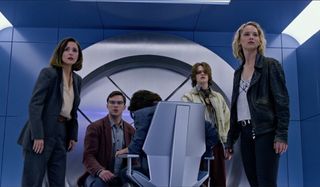
Why Comic Book Movies Are Harder To Make Than Dramas, According To Bryan Singer
Over the course of his career, Bryan Singer has struck a good balance between intense drama and fantasy/sci-fi blockbusters. He broke out back in the 1990s because of the Academy Award-winning The Usual Suspects, and has titles like Apt Pupil and Valkyrie on his resume, but to date he has also made four X-Men movies. Which of these does he view as being more difficult? According to the X-Men: Apocalypse commentary, it's the latter. This is exclusively based on the fact that Singer works to have his superhero movies feature the same level of authentic drama and emotion as his non-comic book related titles, and has to do so with the character's wearing ridiculous outfits. This is pretty funny when you consider that Singer steered the franchise away from comic-accurate get-ups for characters at the very start of the series -- but we still get the sentiment at which he's aiming.
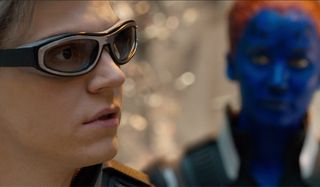
Why Quicksilver Doesn't Tell Magneto He's His Son
While Quicksilver confirms that Michael Fassbender's Magneto is his father in X-Men: Apocalypse, telling Jennifer Lawrence's Mystique about it when they are locked up together, it's information that the speedy hero decides not to share with his dad in the big finale of the film. Given that it would have potentially given Magneto to stop working for En Sabah Nur and continue his life, many have wondered why the young mutant made this decision. According to Bryan Singer and Simon Kinberg, it's all about context for their future relationship post-reveal. The two filmmakers note that Quicksilver doesn't explain their connection because he doesn't want it to possibly poison any kind of bond they could have in the future (what with the reveal happening while the Master of Magnetism is working to end the world). Is it selfish? Sure. But Quicksilver is a flawed individual.
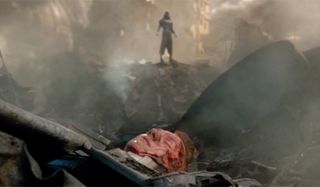
Does Angel/Archangel Die In X-Men: Apocalypse?
In the climactic battle against Apocalypse and his Four Horsemen at the end of X-Men: Apocalypse, Ben Hardy's Angel takes an unfortunate early leave when he finds himself on the X-Men's Blackbird at the wrong moment. While Kodi Smit-McPhee's Nightcrawler was able to teleport the good guys out of the crashing jet in time, the metal-winged mutant was left in the cockpit as it exploded. After that moment, the only shot of him is the one you see above, raising questions about whether or not the fan-favorite character is actually dead. Bryan Singer addresses this on the film's commentary track... and basically leaves the answer up to any future X-Men filmmakers who find a way to possibly utilize him in the future. Singer praises the character a great deal, and is completely non-committal in terms of saying whether or not we've seen the end of his big screen run. (We personally hope that he did survive, simply because he's an important hero in the legacy of the comics)

Why Professor X's Chair Is Extra Special At The End Of The Film
In the last 16 years, we've seen Professor Charles Xavier roll around in a number of different kinds of wheelchairs -- with X-Men: Days of Future Past even going as far as to introduce one without wheels. In case you didn't catch it, however, there is something particularly special about the one that James McAvoy is sitting in at the end of X-Men: Apocalypse. That, in fact, is the same chair that Patrick Stewart sat in during the making of the first X-Men movie all the way back in 2000. It wasn't easy to find and acquire, as the prop had been purchased by a collector that they needed to track down, but they managed to get it in time to be featured in the closing shots of the latest blockbuster in the franchise.

Eric Eisenberg is the Assistant Managing Editor at CinemaBlend. After graduating Boston University and earning a bachelor’s degree in journalism, he took a part-time job as a staff writer for CinemaBlend, and after six months was offered the opportunity to move to Los Angeles and take on a newly created West Coast Editor position. Over a decade later, he's continuing to advance his interests and expertise. In addition to conducting filmmaker interviews and contributing to the news and feature content of the site, Eric also oversees the Movie Reviews section, writes the the weekend box office report (published Sundays), and is the site's resident Stephen King expert. He has two King-related columns.
Most Popular




